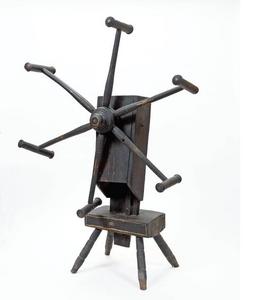

An example of a weasel, sometimes called a popping jenny, is shown above. (Photo by James H. Price)
The object to the right is a weasel, or sometimes called a popping jenny. It's a winder, one of many pieces of equipment used in early home textile production. When it measures an exact length of yarn, a skein, the weasel makes an audible "pop" – pop goes the weasel, just like the nursery rhyme. This popping jenny belonged to Virginia Parks Vance (b. 1874) of Washington County, Va., and is decorated with black paint over grey and gold highlights, plus little stars on the tips of the handles. It has been handed down through Virginia's family and is currently treasured by her great-granddaughter. One like it was probably used in c. 1885 by Mary Jane Elam Culbertson of Scott County, Va., when she made the coverlet shown here that is now owned by her great-grandchild.
The tradition of handing down family textiles from mother to daughter to granddaughter has given us a large body of historic textiles to enjoy and study. Handmade blankets, quilts, coverlets, sheets and towels were usually made for everyday use and often worn out. However, something compelled the makers to keep back a few, not to use but to save for their family heritage. They put them away, carefully and lovingly, and each following generation did the same. Throughout the years, these selected textiles were brought out and admired but then returned to the cedar chest, and in this way they have survived, many in pristine condition, for more than a century.
There were, in fact, men who practiced textile production for a living. Edward McFaddon, for example, advertised in Abingdon's newspaper as early as 1812 that he had a weaving shop, and others may have traveled from home to home as itinerant weavers. However, textile production was usually woman's work and a homely endeavor. Many homes had an entire room dedicated to spinning and weaving. It was located in the house, or the basement or even an outbuilding. It needed to be big since the primary piece of equipment, the loom, was very big. Often called a barn loom, it was framed with large, minimally finished logs, and it measured over six feet square. Added to it were the weasel, usually two spinning wheels - one for wool and a smaller one for flax - plus an assortment of smaller hand utensils, like carders, hetchels and scutching knives to prepare the fibers for spinning.
It took a lot of time, and often multiple members of the family worked away at it, children and adults, always guided by mother. The end results were sheets, towels, and plain blankets needed by the family, as well as the more detailed woven coverlets. These beautiful examples of early woman's work, like Culbertson's coverlet, provided not only warmth for the chilly nights of Southwest Virginia and Northeast Tennessee, but also a signature textile for our region's cultural heritage. Many settler families were Scotch-Irish or German, and they brought with them their textile traditions that transferred easily to their new surroundings. The rolling hills, mountains and climate matched their homelands and here they grew the flax and raised the sheep that were the main ingredients for a home textile industry.
A Gift From Grandmother is taken from Backcountry Makers: An Artisan History of Southwest Virginia & Northeast Tennessee. This is the third in a series of articles related to this new book by Betsy K. White. Featuring more than 200 color images, it is in publication by the University of Tennessee Press. Backcountry Makers is White's second book on the history of the region's material culture. The first, Great Road Style: the Decorative Arts Legacy of Southwest Virginia & Northeast Tennessee was published in 2006 by the University of Virginia Press.